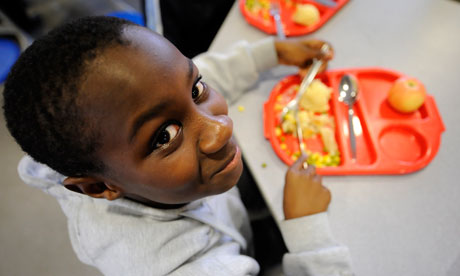
Whatever your views on the announcement that all under-8s in England will be offered free school meals from next September, there's a huge opportunity here. Yes, schools are going to need good support to deliver the great lunchtimes this policy relies on: seriously good food, a pleasant dining space, systems that give kids enough time to eat their meal rather than having to rush, decent kitchen facilities to allow staff to do the job well. But this is about more than what happens during the midday break.
Coupled with plans for a greater focus on food in the revised curriculum from next September, it's going to be an invaluable time to build learning about food into the wider school day. Try these ideas:
• Involve pupils in school meals. Sounds blindingly obvious, but you'd be surprised how often schools tell me they've never asked children what they think of the menu. A simple questionnaire will do the trick. Not only will you get valuable feedback for your kitchen team, you'll also get a good sense of what interests your pupils about food, ideas for discussion in class, find links with other project work and ways to get them enthused and inspired.
Put them in the driving seat by starting a School Nutrition Action Group – a group of pupils who will gather feedback from their peers, give you their insight on any issues at lunchtime and feed back to you regularly. Test new dishes with groups of students and use their views. You could even give one pupil each term the chance to work with your kitchen team to design their own new dish to go on the menu, blogging about their experience. A group of schools in Suffolk are already trying this and it's a concept we want to see more of around the country.
• Make your kitchen team a big part of the school day. Involve them in lessons, assembly and food projects. They can be fantastic role models for getting children excited about cooking and eating well.
• Use food as a teaching tool. Bring history to life by getting children cooking dishes from the period you're studying; get kids researching what their peers eat for school lunch in a different country, then have a tasting session in class; give art a different flavour by designing a picture on the topping of a home-made pizza
• Start a cooking club. Research shows the huge impact these can have for children's interest in food and healthy eating. Use your club to complement what you're doing on food during teaching time and don't underestimate its power to get parents into school. The country's largest network of cooking clubs for children, Let's Get Cooking, is a good place to start for information.
• Get prepared for the changes to the curriculum now. If you're worried about the skills of your staff to deliver more practical cooking from next September, finding space in your school that will work for cooking sessions or you're simply looking for ideas, there is lots of support out there.
• Get your headteacher on board. Without exception, schools that are doing a great job on food and food education are those where the head is passionate about helping children to eat well.
Jeremy Boardman heads up the Children's Food Trust's schools support programme. Visit www.childrensfoodtrust.org.uk for more information.
This content is brought to you by Guardian Professional. Looking for your next role? Take a look at Guardian jobs for schools for thousands of the latest teaching, leadership and support jobs.

